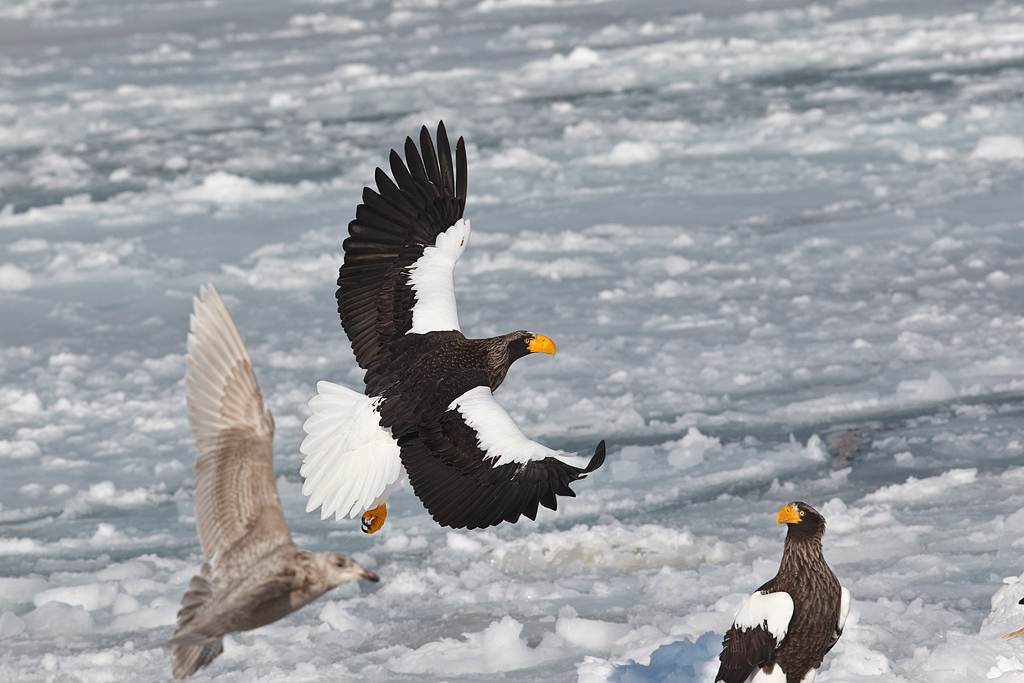.jpg) Steller's sea eagle (Haliaeetus pelagicus) is a large bird of prey in the family Accipitridae found in coastal northeastern Asia and mainly preys on fish and water birds. On average, it is the heaviest eagle in the world, at about 5 to 9 kg (11 to 20 lb), but may be below the harpy eagle (Harpia harpyja) and Philippine eagle (Pithecophaga jefferyi) in some standard measurements. This bird is named after the German naturalist Georg Wilhelm Steller.This species was first described as Aquila pelagica by Peter Simon Pallas, in either 1811 or 1826 depending on the source. Subsequently, many generic and specific names have been variously spelled, e.g., Haliaetus pelagicus, Haliaetos pelagica, Faico leucopterus, Faico imperator, Thalassaetus pelagicus, Thalassaetus macrurus, Haliaeetus macrurus, and most recently Thallasoaetus pelagicus. Besides its normal common name, the species has sometimes been referred to as the Pacific eagle or white-shouldered eagle. In Russian, the eagle has been called morskoi orel (sea eagle), pestryi morskoi orel (mottled sea eagle) or beloplechii orlan (white-shouldered eagle). In Japanese, it is called 0-washi (large eagle or great eagle).
Steller's sea eagle (Haliaeetus pelagicus) is a large bird of prey in the family Accipitridae found in coastal northeastern Asia and mainly preys on fish and water birds. On average, it is the heaviest eagle in the world, at about 5 to 9 kg (11 to 20 lb), but may be below the harpy eagle (Harpia harpyja) and Philippine eagle (Pithecophaga jefferyi) in some standard measurements. This bird is named after the German naturalist Georg Wilhelm Steller.This species was first described as Aquila pelagica by Peter Simon Pallas, in either 1811 or 1826 depending on the source. Subsequently, many generic and specific names have been variously spelled, e.g., Haliaetus pelagicus, Haliaetos pelagica, Faico leucopterus, Faico imperator, Thalassaetus pelagicus, Thalassaetus macrurus, Haliaeetus macrurus, and most recently Thallasoaetus pelagicus. Besides its normal common name, the species has sometimes been referred to as the Pacific eagle or white-shouldered eagle. In Russian, the eagle has been called morskoi orel (sea eagle), pestryi morskoi orel (mottled sea eagle) or beloplechii orlan (white-shouldered eagle). In Japanese, it is called 0-washi (large eagle or great eagle). |
| TWO STELLER'S SEA EAGLES WITH A RAVEN. |
 |
| IN FLIGHT |
 |
| IT HAS AN EXTREMELY LARGE HEAD WHICH IS CONSIDERED TO BE THE LARGEST HEAD EVER MEASURED FROM ALL THE OTHER EAGLES. |
he mature Steller's sea eagle is dark brown to black over the majority of its body, with strongly contrasting white on the lesser and median upper-wing coverts, underwing coverts, thighs, under-tail coverts and tail. Their wedge-shaped, white tails are relatively longer than those of the white-tailed eagle. The bold, pied coloration of adults may play some part in social hierarchies with other eagles of their own species during the nonbreeding season, although this has not been extensively studied. The eyes, the bill, and the feet of adults are all yellow in colouration. Two subspecies have been named: The relatively widespread nominate H. p. pelagicus and the virtually unknown H. p. niger. Korea. Last seen in 1968 and long believed to be extinct, a female matching H. p. niger in appearance was born in captivity in 2001. Both its parent were "normal" in appearance, indicating that H. p. niger is an extremely rare morph rather than a valid subspecies, as had been suggested earlier.
 |
| A STELLER'S SEA E AGLE FEEDING ITS YOUNG. |
The first down plumage of new nestlings is silky white, though they soon turn a smoky brown-grey. As in other sea eagles, remiges and retrices of the first-year plumage are longer than adults. Juvenile plumage is largely a uniform dark brown with occasional grey-brown streaking about the head and the neck, white feather bases, and light mottling on the retrices. The tail of the immature eagle is white with black mottling basally.The young Steller's sea eagle has a dark brown iris, whitish legs and blackish-brown beak. Through at least three intermediate plumages, mottling in the tail decreases, body and wing feathering acquires a bronze cast, and the eye and bill lighten in colour. Definitive plumage is probably reached in the fifth year of life, based on fragmentary data from captives. First and intermediate plumages are difficult to distinguish from those of the white-tailed eagle, which occurs in the entire breeding range of the Steller's.
Steller's sea eagles are not extensively known for their voices, but are known to make a deep barking cry, ra-ra-ra-raurau, in aggressive interactions. Their call is similar to the white-tailed eagles but deeper. During the display at the beginning of the breeding season, they have been heard to make calls to each that sound like very loud, deep-voiced gulls.The relationships of Steller's sea eagle are not completely resolved. data tentatively suggest that this species's ancestors diverged early in the colonization of the Holarctic by sea eagles.
 |
| TWO OF THEM. |
Steller's sea eagle breeds on the Kamchatka Peninsula, the coastal area around the Sea of Okhotsk, the lower reaches of the Amur River and on northern Sakhalin and the Shantar Island, Russia. The majority of birds winter farther south, in the southern Kuril Islands, Russia and Hokkaidō, Japan. That being said, Steller's sea eagle is less vagrat than the white-tailed eagle, usually lacking the long-range dispersal common in juveniles of that species. Vagrant eagles have been found in North America, at locations including the Pribilof Islands and Kodiak Island, inland to as far as Peking in China and Yakutsk in Russia's Sakha Republic, and south to as far as Taiwan, but these are considered to be individual eagles that have strayed far from the species' typical range.
No comments:
Post a Comment